My another purpose is to bought POLAROID CAMERA!!! I'll grasp my dad's promise. May be it just take half year, because I want to use this camera on IED FITRI @crb
 |
Paket 4 Plain: 272K |
 |
Leather Bag Instax 7s: 125K |
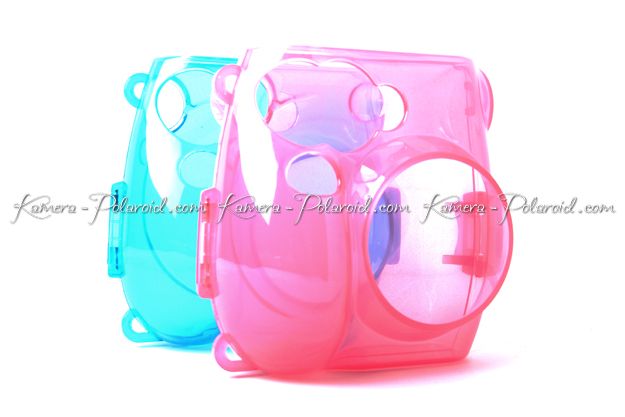 |
Polaroid Instax 7s Pink: 700K |
 |
Paket 4 Plain: 272K |
 |
Leather Bag Instax 7s: 125K |
 |
Polaroid Instax 7s Pink: 700K |
Talk about university again. I've never bored to talk about it and I hope you guys too. BYU's my nearest BIG YES. Can't hold to study there. This is the dream that will be reached soon. Now, I can only imagine the university from the computer, but later I'll feel the atmosphere in real. This is several buildings in BYU that I would like to explore, but first I wanna show you the map of BYU:
 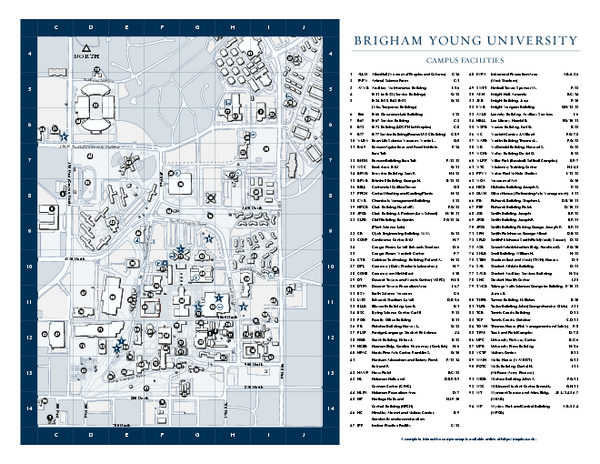  |
| Physical Plant Central Heating Plant: PPCH: This building was designed by Joseph Nelson with Morris Snell superintending construction. |
 |
| BYU Jerusalem Center: JRMC: Brigham Young University began conducting "studies abroad" in Jerusalem in 1968. This program was very successful and, eleven years later in 1979, Church leaders decided to build a structure that would serve both the needs of the university and the Mormon community in Jerusalem. This building sits on Mount Scopus overlooking the Mount of Olives, the Kidron Valley and the Old City. |
 |
| Museum of Art: MOA: The MOA is a four-story, modern facility of more than 102,000 square feet. |
 |
| Bean (Monte L.) Life Science Museum: MLBM: Named after Monte L. Bean, the museum contains research collections of vascular and non vascular plants, as well as invertebrate and vertebrate animals. |
 |
| Wilkinson (Ernest L.) Student Center: WSC: This building, completed in 1964, was named for Ernest L. Wilkinson, sixth president of BYU (1951–1971). Planning for the center took 12 years, and 60 percent of the cost was paid by students. The BYU Bookstore takes up one corner of this building. Also in the building are food services, including a food court with franchise restaurants, a high class restaurant taking up the sixth floor, BYU catering's central operations and two other places to buy food not connected with any of the above. The building also has conference rooms, two large ballrooms, a movie theatre, a full-service copy center, a post office and a bowling alley are among its many facilities. There is also a barber shop and salon and a craft and flower store. The building also housing the Dean of Students Office, various counseling and conflict resolution offices, and various other student services offices. |
 |
| Culinary Support Center (BYU Creamery): CSC: The BYU Creamery Outlet and its related locations serve as grocery stores for the campus and provides freshly made dairy products. BYU Creamery has four locations: Creamery on Ninth East, Creamery Outlet, Helaman Creamery, and Wyview Creamery. |
 |
| Smith (George Albert) Fieldhouse: SFB: A 5,000 seat multi-purpose arena named after George Albert Smiththe eighth president of The Church of Jesus Christ of Latter-day Saints. A 28,950-square-foot (2,690 m2) addition was built onto the building in 1959 and another in the 1960s. |
 |
| Richards (Stephen L.) Building: RB: The Richards Building includes 3 Olympic sized swimming pools. An addition to the north end of the building, including additional dance practice rooms was completed in 2008. |
 |
| Marriott (J. Willard) Center: MC: Named after benefactors J. Willard and Alice Marriott, the Center is a 22,700-seat multipurpose arena that is home to the BYU Cougars men's and women's basketball teams and is the site for campus devotionals. It is currently the third-largest on-campus arena in the country. |
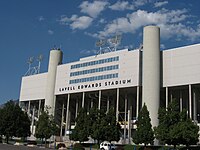 |
| Edwards (LaVell) Stadium: LVES: The BYU football stadium with seating capacity of 63,470. |
 |
| University Press Building: UPB: This building replaced the temporary building just west of the Herald Clark building that had served as the press building since 1946. This is the location of printing operations for Brigham Young University Press. |
 |
| Smoot (Abraham O.) Administration Building: ASB: Named after Abraham O. Smoot, the ASB is the main administrative building on campus and houses the president's office. The building was designed by Henry P. Fetzer. |
 |
| McDonald (Howard S.) Building: MB: Named for Howard S. McDonald, former president of BYU. This was the location of the Student Health Center from 1955 until 1999 when it moved to its current location. The student health service had began in 1946 and been located in a small frame building by the Eyring Science Center until moving to this location. When the McDonald Building was built it also housed the Air Force ROTC unit that was located at BYU |
 |
| Hinckley (Gordon B.) Alumni & Visitors Center: HC: Named after Gordon B. Hinckley, the fifteenth President of The Church of Jesus Christ of Latter-day Saints, the Gordon B. Hinckley Alumni and Visitors Center serves as the gateway to campus and houses the Alumni Association, Guest Relations and Public Affairs, Annual Giving and School Relations. |
 |
| Fletcher (Harvey L.) Building: FB: This building was originally built as the engineering building. The first phase had as its architect Lawrence D. Olpin and was built from July to October in 1953. It was originally a one story building. Three of the four wings received a second story in 1954. Despite being intended for engineering, when it was first built it also housed the English and other departments due to the severe lack of adequate office space on campus. |
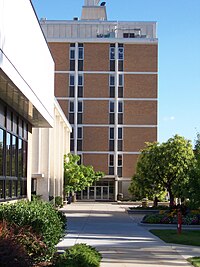 |
| Widtsoe (John A.) Building: WIDB: Houses College of Biology. There is a collection of about 40 marine tanks in the underground area of the building with sea animals that can be viewed by anyone going into the building. |
 |
| University Parkway Center: UPC: This building houses the English Language Center for foreign students learning English as a second language. |
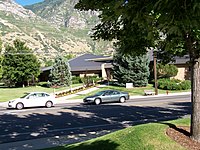 |
| Taylor (John) Building (Comprehensive Clinic): TLRB: This building has been the comprehensive clinic from its first use. It was built to provide a single location for those in the human services discipline, and provides marriage, family, child, adolescent and individual therapy and counseling as well as doing various forms of diagnostic testing. |
 |
| Tanner (N. Eldon) Building: TNRB: Houses the Marriott School of Management |
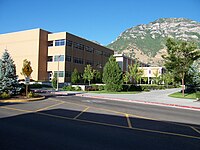 |
| Talmage (James E.) Math Sciences/Computer Building: TMCB: Named for LDS Apostle and scientist James E. Talmage. When it was built it housed the Computer Science, Math and Statistics departments. It also housed The BYU Research Center and the Office of Institutional Research. It had 25 classrooms as well as its offices and computer rooms. At the time of construction it had 61,000 square feet (5,700 m2). A large addition was later built onto the west end of the building. |
 |
| Snell (William H.) Building: SNLB: Originally home of the College of Industrial and Technical Education. This college was merged into the College of Engineering and Technology in the 1970s and this building was one of the buildings used by the new college. |
 |
| Smith (Joseph F.) Building: JFB: Named after Joseph F. Smith, the JFSB is home to the History, Sociology, Social Work, and the School of Family Life departments, as well as many research centers and institutes within the College of Family, Home, and Social Sciences. The building is also shared with the College of Humanities. |
 |
| Nicholes (Joseph K.) Building (Chemical Stores): NICB: Physically attached to the much larger Ezra Taft Benson Building, but the Nicholes building is older than the Benson building |
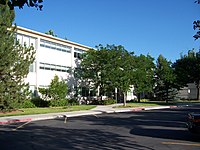 |
| McKay (David O.) Building: MCKB: The David O. McKay building is named for David O. McKay a Latter-day Saint educator and president of the church when it was built. It houses most of the offices and many classrooms of the David O. McKay School of Education. When initially built the English, Modern Languages, History and Political Science Departments were also located here, but they would all later move to other buildings as thephysical plant of the campus grew. |
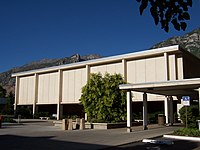 |
| Martin (Thomas L.) Building: MARB: Mainly consists of lecture halls. This includes four that have seating capacity of 254 students. The building is also used extensively for BYU LDS Wards to meet, since such sized rooms are ideal for sacrment meeting at least in area. This building, with its primary focus on science and liberal arts classes, rarely houses fine arts classes and has multiple pianos in it. |
 |
| Maeser (Karl G.) Building: MSRB: Named after Karl G. Maeser, the MSRB currently houses a lecture hall and the administrative offices for the University's Honors Program. |
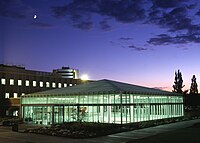 |
| Lee (Harold B.) Library: HBLL: The Lee Library, completed in 1961, was originally named the J. Reuben Clark Library, but when BYU named its law school after President Clark, the library name was changed to honor President Harold B. Lee. Included in the library are archives and manuscript collections of Western American history, historical film and music collections, and a learning resource center offering all types of media. The library's LDS family history facility is the second-largest in the world. With more than three million volumes in the university's library collection, and nearly half of those books in storage off-campus, an addition to BYU's large library was long overdue. The 234,000-square-foot (21,700 m2) addition to the library opened in the fall of 1999. |
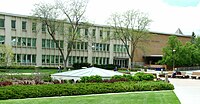 |
| Knight (Jesse) Building: JKB: Named after Jesse Knight. When it was first built the Jesse Knight Building was the business building. It was significantly expanded in 1966. After the Tanner Building was built the Jesse Knight Building became the location of the College of Humanities. However with the completion of the new Joseph F. Smith Building in 2005 some humanities functions were shifted out of the Jesse Knight Building, and some non-humanities institutions have moved into the building, so it is no longer known as the Jesse Knight Humanities Building (JKHB) as it was for many years. Currently the Jesse Knight Building is the location of the BYU Police, Freshman Academy administration, Human Resource Development, the Visual Arts department (in theBYU College of Fine Arts and Communications), the English Writing Center, the Humanities Publications Center, School of Management computer laboratories, and classrooms. |
 |
| Knight (Amanda) Hall: AKH: Originally used as a residence hall. Funded by the Jesse Knight Endowment Fund, and named for Jesse Knight's wife Amanda. Later it was part of the Language Training Mission of the LDS Church. For a time during the 2000s housed part of the Department of Communications. |
 |
| Kimball (Spencer W.) Tower: SWKT: Named after Spencer W. Kimball, the SWKT (pronounced "Swicket") is the tallest building on campus and also the tallest building in Provo. It stands approximately 160 feet (49 m) tall (12 stories), and houses several departments and centers, including Political Science, Neuroscience, Nursing, Geography and Geology departments, as well as classrooms, faculty offices, an auditorium, and a large computer lab. |
 |
| Harris (Franklin S.) Fine Arts Center: HFAC: Named after Franklin S. Harris, the HFAC (colloquially known as the FiSHFAC) houses the School of Music, the Department of Theatre and Media Arts, the Department of Visual Arts, BYU Broadcasting, and the Division of Design and Production. It has various classrooms, as well as 53 practice rooms and four art galleries. The building also houses several concert and play halls—the largest which is the De Jong Concert Hall. |
 |
| Grant (Heber J.) Building: HGB: The Heber J. Grant Building was originally the BYU Library. After the library moved to its current location at the Harold B. Lee Library the building has served many functions. For a time it housed the BYU Honors Program. It was also the first location of the BYU Faculty Center. Currently it houses the BYU Testing Center, the Religious Studies Center and also has a few classrooms. |
 |
| Former Presidents' Home: FPH: This is the location of the offices of BYU's Graduate Studies |
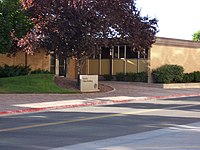 |
| Faculty Office Building: FOB: This building began in the 1950s as ticket offices, but when the adjacent stadium was replaced by the Edwards Stadium, the old ticket offices were expanded and turned into the faculty office building. |
 |
| Eyring (Carl F.) Science Center: ESC: Named after Carl F. Eyring who was a BYU professor. This building contains the Royden G. Derrick Planetarium. Eyring was an acoustical physicist and dean of BYU's College of Arts and Sciences, the predecessor of about five of the current colleges. |
 |
| Clyde (W.W.) Engineering Building: CB: The Clyde Building houses the College of Engineering and Technology. More than 40 percent of the total floor space is used for laboratory instruction and research in electrical, chemical, civil, and mechanical engineering, as well as for engineering analysis and interdepartmental functions. It also houses a solid-state laboratory, many large study rooms, and facilities for environmental, high-pressure, saline water, thermodynamics, nuclear, and transport processes research. |
 |
| Clark (Herald R.) Building: HRCB: Originally known as the Student Service Center, one of the main functions of this building when it was built was housing the BYU bookstore, a function it continued until the bookstore relocated to its current location in the Wilkinson Student Center.[7] The Clark building also from very early one housed various academic departments. For example, until about 1965 this was the location of the journalism department of BYU. The building is currently the headquarters of theDavid M. Kennedy Center for International Studies. |
 |
| Brimhall (George H.) Building: BRMB: Originally built as a one story building. It housed the Student Army Training Corps as its first function, since it was completed during World War I. It was then called the mechanical arts building. After the SATC was no longer on BYU campus the building was used by the department of mechanical arts for such things as black smithing and woodworking classes. In 1935 the second and third stories were added and the building was renamed in honor of George H. Brimhall, who had been BYU president when it was built. Another renovation was done in 1984 which expanded the structure. At this point the building housed several programs of the Department of Visual Arts. In 2004 the building underwent significant renovation and then became the location of BYU's Department of Communications. |
 |
| Centennial Carillon Tower: BELL: 152 feet tall with 52 bells. |
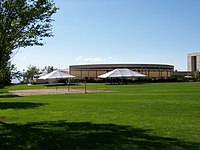 |
| BYU Conference Center: CONF: It is located on the northeastern part of the BYU campus, with great views of the nearby mountains, and shares a lobby with the Harman Continuing Education Building (HCEB). The Conference Center is primarily used for university sponsored conferences and events, but is also available for family events, and may be utilized as a space to have an off-site meeting or meal for a business or other organization.
The BYU Conference Center has two main levels with availableconference space. The lower level features nine rooms, with largeboardroom tables, and seven medium rooms that may be set to meet most of your event needs. The main level features a registration or check-in room, an auditorium that seats up to 300 people, a large banquet hall that can seat up to 250 people for buffet luncheons and dinners, and an additional ten rooms varying in size. These rooms may be set to meet your event needs. The Conference Center also features a large outdoor covered pavilion, often used for summer banquets and wedding receptions, and a large grass field. The BYU Conference Center has an on-site multi-media center, and can meet most audio-visual requests for your event.
|
 |
| Benson (Ezra Taft) Building: BNSN: Building is a science building, primarily housing the offices and classrooms of the chemistry department |
